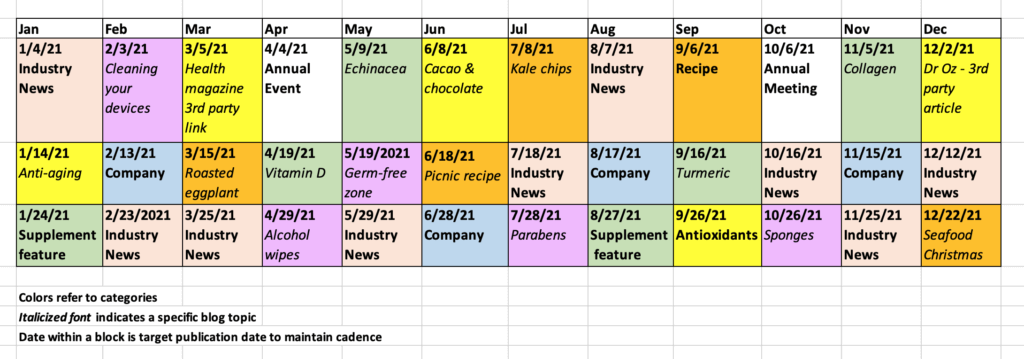
In the first post in this series, we reviewed how an editorial calendar can provide some needed structure for maintaining blog posting cadence. We suggested using a chart or spreadsheet to document categories, or content themes. Hopefully you found some time to do the recommended follow up, creating your own chart of possible blog categories, along with ideas for blog posts within some of the categories. Now we are ready to take the next steps in building our editorial calendar.
1. Refine your list of categories
Review your themes from the perspective of demonstrating your expertise and driving calls to action. Are the themes you’ve chosen going to help motivate customers to take the action you want them to take?
Add themes that are missing, and combine related themes into broader categories. Then consider whether each theme should be equally weighted, or (based on your goals and target audience), whether some themes should be weighted more heavily. In addition to themes that merit more frequent posts, you may have some that apply only occasionally, such as an annual event; that’s fine. Variety is good.
On your document or spreadsheet, label this tab Categories.
2. Drill down to publication dates
Create a second section on your document, called Calendar, with the months in a row across the top. In rows beneath each month, add target publication dates. Blogging should be done relatively frequently, ideally every week or two. While you don’t have to blog on a precise schedule, you want to establish and maintain a regular cadence. If you blog weekly, you’ll typically have four rows for each month. Using a calendar as a reference, add a block for each publication date for the rest of the year. Now you know the dates when you’ll need to publish.
On our sample calendar, note that we’ve used a different color for each blog category or theme, to make it easy to see the relative frequency of each.
3. Assign a category or topic to each scheduled blog post
Using the colors you associated with each category, color code the blog post blocks in the calendar section. Add a category name, or if you have blog topics, populate the block (or cell) with the blog topic. Your blog post blocks now show the category, targeted publication date, and in some cases, the blog post topic.

When you are populating cells with potential blog topics, consider seasonality for your business. If you’re in retail, plan for a back-to-school post in early August and one for holiday shopping in November. If your company is in the wellness space, New Year’s resolutions often center around better health – schedule a blog post in December or right after January 1 for this topic. Think about themes that relate to your industry and add timely blog topics to address the interests of your potential customers.
Assign categories (or if you have them, blog topics) to the posting dates for a minimum of several months in advance. In so doing, you have created a planning tool that can help you to get focused quickly on content creation when it’s time to post your blog.
But even the best planners get derailed at times, so to maintain cadence, we recommend creating evergreen posts that can be used when you don’t have time to create content.



One Comment